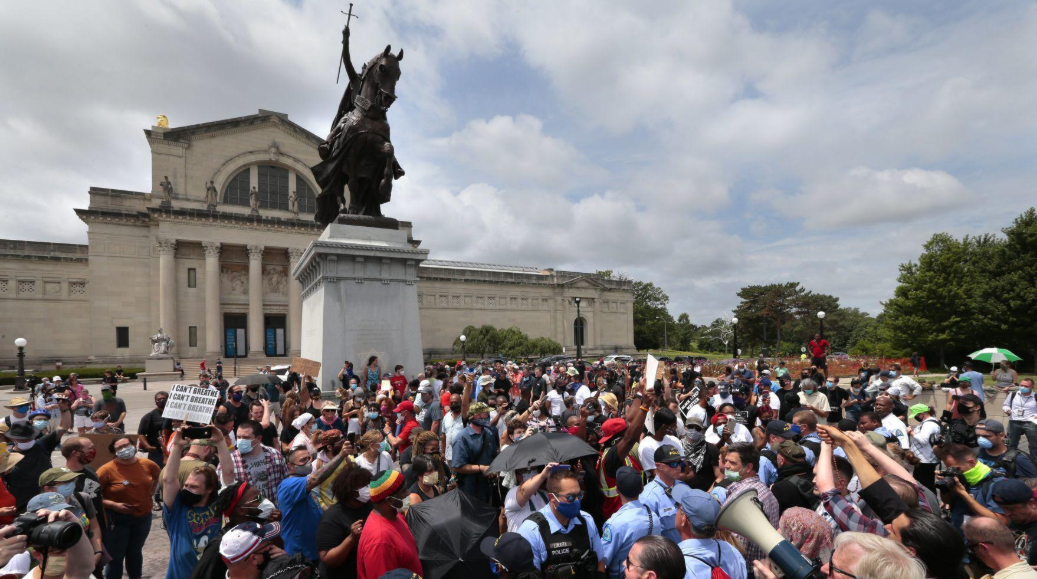On June 27th, protestors and counter-protestors outside the Saint Louis Art Museum faced off around a statue titled The Apotheosis of Saint Louis, depicting King Louis IX of France raising the cross astride a decorated horse. One side chanted “Black Lives Matter” and called for the statue’s removal, while the other said Hail Marys and defended the statue. The confrontation was one more eruption in the ongoing battle over statues and the legacy of racism in the United States.
This time, though, the conflict centered on the specifically Christian role in the history of white supremacy, and a complicated one at that. King Louis IX, who was canonized as a saint in the Catholic Church in 1297, was not a Confederate war hero, nor a “New World” colonizer, but a medieval sovereign, the only king of France the Catholic Church has ever named a saint.
“He’s gonna come down,” said Umar Lee, a St Louis activist and organizer of the protest. “This guy right here represents hate, and we’re trying to create a city of love. We’re trying to create a city where Black lives matter.” For the anti-statue protestors, the statue is associated with anti-semitism and Islamophobia, since St. Louis persecuted and expelled the Jews from France and fought Muslims in two Crusades.
The counter-protestors, consisting of a loose hodge-podge of Catholics and various right-wingers, see the conflict quite differently. Amid the chants, local priests seized on the moment to defend the history of St. Louis. “St. Louis was a man who willed to use his kingship to do good for his people,” said Fr. Stephen Schumacher. After the clash, the Archdiocese of St Louis responded to the protest in a press release saying:
“The Archdiocese of St. Louis is encouraged by the winds of change that are at hand, but believes that this energy of change should be focused on programs and policies that will dismantle racism…. We should not seek to erase history, but recognize and learn from it, while working to create new opportunities for our brothers and sisters.”
On the one hand, the Black Lives Matter activists argue that the colossal statue of King Louis IX, along with others like it, represent white supremacy and the terror that has always accompanied it. Moreover, whatever he did in his own time, a statue of a medieval king of France only shows up in a place like Missouri because of a long history of colonization and Eurocentrism. The desire to tear the statue down is therefore an attempt to publicly recognize the violence of these histories and overturn the narratives that prop up systems of racism.
On the other hand, counter-protestors argue that Saint Louis IX is a good, moral example for people, especially Catholics, to learn from. Furthermore, they worry history will be irrevocably lost if we allow, as Bishop Donald Hying of Madison said, “random groups in the current moment of anger” to decide which images and monuments remain.
At the root, the arguments over statues and their removal are about how hegemonic regimes of power construct a history that supports and legitimates their continued wielding of power. To talk about statues of saints is to talk about the hegemonic power of Christianity. St. Louis is, of course, not an isolated example. In June, protesters in Los Angeles toppled a statue of St. Junipero Serra, a recently (and controversially) canonized 18th century Franciscan friar. St. Serra was responsible for establishing an extensive mission system across California designed to assimilate Indigenous populations, a process that regularly involved abuse, forced labor, and cultural genocide. In July, Alexandria Ocasio-Cortez referred to a statue of St. Damien of Molokai in the US Capitol as an example of patriarchy and white supremacy.
While both of these examples are directly related to the colonial history of the United States, the drama around St. Louis is even more instructive precisely because it is more removed. A statue of a French monarch in a city named after him, established on indigenous land, testifies to the victory of settler colonialism.
* * *
In his famous essay “Theses on the Philosophy of History,” Walter Benjamin explores historical memory, who we valorize in that memory, and, most importantly, who we forget. The world we experience and move through as “normal,” the present in which we live, says Benjamin, rests not on the noble deeds of founding fathers and lofty, enlightened ideals, but on a foundation of brutality, violence, and domination.
It’s a common adage that history is written by the victors, and victories rarely come without blood. “Whoever until this day emerges victorious, marches in the triumphal procession in which today’s rulers tread over those who are sprawled underfoot,” writes Benjamin. Those in power today have inherited a world that was made and re-made through exploitation, genocide, expulsions, and so on, and their power, reliant on these violent origins, continues in triumphal procession. Benjamin is not only interested in revealing the violence underneath the powerful, however; he is also concerned with how that violence is commemorated. “The spoils are, as was ever the case, carried along in the triumphal procession. They are known as the cultural heritage.”
Toppling statues of saints may seem like an accident of excess, of protesters getting thoughtlessly caught up in the thrill of the deed. But accusations of fanaticism have long been reliable means to deny or ignore the logic of a movement. For those in power to be dismayed by or dismissive of the desire to remove a statue of a saint like Serra or Louis is an admission of profound ignorance at best and cynical performative outrage at worst. History is indeed written by the victors, and Christian history, especially in the great colonial success story of the United States, is no different. Our “cultural heritage,” our statues of the saints, are the spoils of domination.
St. Louis dined with the poor—but surely this hardly makes up for severely persecuting the Jews in France. St. Serra’s defenders often suggest that he advocated for the Indigenous people in his mission, but they fail to inquire into the coercive violence of the mission system itself and its role in European colonialism. As Amaryah Armstrong reminded us recently, Christianity is the engine that made the order of our world, a racializing and brutal order joined to a theology of redemption.
In what is undoubtedly the most famous of Benjamin’s theses, we are invited to consider Paul Klee’s painting Angelus Novus, which depicts an angel with its wings spread open. Benjamin interprets the subject as the Angel of History. “Where we perceive a chain of events,” Benjamin writes, the angel “sees one single catastrophe which keeps piling wreckage upon wreckage and hurls it in front of his feet.” Those in power use the wreckage of history to construct historical narratives that cast the violence of Christian hegemony in a heroic and morally upright light.
For Benjamin, a historical materialist is not caught up in the triumphal procession of brutality, but, on the contrary, “what he surveys as the cultural heritage is part and parcel of a lineage which he cannot contemplate without horror.” Knowing the cost of our cultural heritage, one cannot help but see a monument to a colonial past or present, even a saintly one, as anything other than a monument to terror. Faced with a ubiquitous commemoration of violence, Benjamin says revolutionaries see it as their “task to brush history against the grain.”
To rush to the defense of saintly statues in the name of religious and cultural heritage is to continue along the smooth grain of Christianity’s history of domination. Working to brush Christianity against the grain reveals that the history of Christianity is not politically neutral, and that Christianity has been weaponized and wielded against the oppressed. To avoid this indictment, some Christians choose to interpret this history of violence theologically. For them, Christianity can be disassociated from its violent history by appealing to an ideal Christianity that is defined by doctrine and orthodoxy, meaning every instance of Christian violence is an untrue or heretical formulation of an otherwise pure Christianity. But whether true or untrue, heretical or orthodox, Christianity is what it does. To write off the Christian racial order as simply false or as heresy lets Christians off the hook too easily, a point theologian Marika Rose explores in A Theology of Failure. Rather, to brush Christianity against the grain means to let in the whole of Christian history, to metabolize it all and become accountable for the violent inheritance of Christianity.
* * *
Letting the whole of Christianity in, with all its accumulated wreckage, what else could one suggest but to divest from Christianity’s violent cultural heritage? Divesting of the world-making legacy of Christian racial order involves, at the very least, overturning the cherished “high points” of our historical narratives and the monuments that reinforce those narratives. The point would not be to reveal a neutral or objective history. As Benjamin says, “To articulate what is past does not mean to recognize ‘how it really was.’ It means to take control of a memory, as it flashes in a moment of danger.” Rather, we must sift through the wreckage to find the embers that are still smoldering, to discover a revolutionary history that might give way to a revolutionary present.
But how can we interrupt the triumphal procession of the ruling class, the order built on violence which is presented as normal and revered as heritage? While the rulers have trampled many underfoot, Benjamin says they cannot stomp out the stirrings of resistance. Though the current order is founded on a chain of violence, there is likewise a chain that links the victims of history. In fact, says Benjamin, “there is a secret protocol between the generations of the past and that of our own. For we have been expected upon this earth.” The past has a claim. Protestors are responding to that protocol when they tear down a monument that functions as a node in a system of oppression.
It is difficult to accept that Christianity is responsible for that system, but the protests also bring good news: such a system can be torn down. Whereas bishops and other detractors worry that destroying these statues prevents us from learning and accelerates collective historical ignorance, we might instead understand these protesters as “grabbing the emergency brake” of history, as Benjamin says in his unfinished Arcades Project, in order to interrupt the macabre procession and force our attention toward those whom Christianity has dominated.
Besides, if the saints memorialized in statues are truly saints, now purged of all their earthly sin, then they are already aware of the violence they committed and licensed. They are aware, too, of how their images are weaponized to cover over that violence, memorialized as the spoils of the ruling class’s triumphs. Knowing that Jesus will one day judge us based on how we treated the least of these, it is hard to believe that the saints are more concerned about their reputation and statues than the agency of the oppressed. Saved from the sins of anti-semitism, colonialism, and racism, perhaps we might even imagine these saints interceding on behalf of those who are working to destroy the social order they have prepared and come to represent.
Dean Dettloff and Matt Bernico are co-hosts of The Magnificast, a podcast about Christianity and leftist politics. They’ve written for The Bias Magazine here and here.




